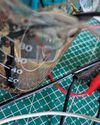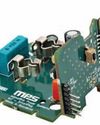DRAMS: Technology And Beyond
Electronics For You
|December 2023
DDR5, the fifth-gen DRAM, demands digital-analogue finesse in its MC and DDR PHY. Unique timings, coupled with emerging tech like 3D XPoint, MRAM, and ReRAM, mark a paradigm shift
-

Memory is typically used for storing the data or program code needed by a computer processor to function. To accomplish this task, Dynamic random access memory (DRAM) is employed. DRAM is a common type of random access memory (RAM) used in personal computers (PCs), workstations, and servers. Random access allows the PC processor to access any part of the memory directly rather than proceeding sequentially from a starting place.
How does DRAM work?
Memory is made of bits of data or program code arranged in a two-dimensional grid. DRAM stores bits of data in what's called a storage or memory cell, consisting of a capacitor and a transistor. The storage cells are typically organised in a rectangular configuration. When a charge is sent through a column, the transistor in the column is activated. A DRAM storage cell is dynamic, meaning that it needs to be refreshed or given a new electronic charge every few milliseconds to compensate for charge leaks from the capacitor.
The memory cells work with other circuits that identify rows and columns, track the refresh process, instruct a cell whether or not to accept a charge, and read or restore data from a cell.
DRAM is one option of semiconductor memory that a system designer can use when building a computer. Typical sizes of DRAM are about 1 to 2GB in smartphones and tablets and 4 to 16GB in laptops.
Advantages of DRAM
• Very dense
• Low cost per bit
• Simple memory cell structure
Disadvantages of DRAM
• Complex manufacturing process
• Data requires refreshing
• More complex external circuitry required (read and refresh periodically)
• Volatile memory
• Relatively slow operational speed
Manufacturing processes involved in DRAM
このストーリーは、Electronics For You の December 2023 版からのものです。
Magzter GOLD を購読すると、厳選された何千ものプレミアム記事や、10,000 以上の雑誌や新聞にアクセスできます。
すでに購読者ですか? サインイン
Electronics For You からのその他のストーリー

Electronics For You
Tech Majors Are Racing TOWARDS NET-ZERO - What About You?
Apple, Microsoft, Amazon, Google, Infosys, Wipro—global and Indian firms are heading closer to achieving net-zero emissions, a mandate to combat climate change. Here is what you need to know to start your journey...
12 mins
December 2025

Electronics For You
Miniature IoT WATER TDS And LEVEL MONITOR Cum CONTROLLER
For setups that rely on stored water, clear awareness of tank level and water quality is essential.
3 mins
December 2025

Electronics For You
The Impact Of GENERATIVE AI On The Future Of AUTOMOTIVE AND EVs
Autonomous vehicles, connected ecosystems, and smart factories are only the beginning. Generative Al is pushing the auto industry beyond predictions into a bold era of creativity-from EV design to real-time diagnostics and showroom automation. Here is how GenAl is reshaping innovation across the automotive value chain.
8 mins
December 2025

Electronics For You
How AI Tools Are Making SOFTWARE DEVELOPMENT BETTER
AI is reshaping how we code, debug, and collaborate. From Copilot to automation, it is changing software development in ways worth exploring.
3 mins
December 2025
Electronics For You
How AI Tools Are Making SOFTWARE DEVELOPMENT BETTER
AI is reshaping how we code, debug, and collaborate. From Copilot to automation, it is changing software development in ways worth exploring.
3 mins
December 2025

Electronics For You
5 Interesting Reference Designs FOR SMART HOMES
Smart home devices are transforming the way people interact with their appliances. They make homes more convenient, secure, and energy-efficient. From smart plugs and energy monitors to smart locks and thermostats, reference designs help design engineers create connected products that are easy to use, consume less power, and are reliable. These designs allow you to control devices remotely, track energy use, extend battery life, and automate routines. They provide practical solutions for upgrading homes and small commercial spaces without major modifications.
3 mins
December 2025

Electronics For You
Fancy USB LED VASE
This USB LED vase is a simple yet elegant device that fuses art with electronics to create a decorative lighting display. Powered directly from a standard USB port, it uses readily available components such as MOSFETs, resistors, capacitors, and LEDs to produce a striking, dynamic sequence of lights.
3 mins
December 2025

Electronics For You
"WHAT OTHERS SELL IN FOUR BOXES WE BUILT IN ONE"
Years of custom field work are shaping a product line with its own cloud, its own hardware, and a market that is now beginning to recognise its value.
8 mins
December 2025

Electronics For You
BUILD LARGE LANGUAGE MODELS
Large language models are machine learning models designed for a range of language-related tasks such as text generation and translation. Here’s how open source software can help you build your own large language model.
6 mins
December 2025

Electronics For You
Rare Earth Or Rare Ingenuity? India Remains Between The Two
With China firmly controlling rare earth exports, India confronts a critical moment in its technological trajectory.
8 mins
December 2025
Translate
Change font size

